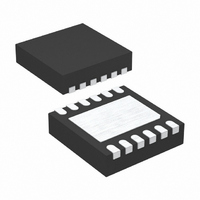LT3498EDDB#TRMPBF Linear Technology, LT3498EDDB#TRMPBF Datasheet - Page 12

LT3498EDDB#TRMPBF
Manufacturer Part Number
LT3498EDDB#TRMPBF
Description
IC LED DRVR WT/OLED BCKLGT 12DFN
Manufacturer
Linear Technology
Type
Backlight, OLED, White LEDr
Datasheet
1.LT3498EDDBTRMPBF.pdf
(24 pages)
Specifications of LT3498EDDB#TRMPBF
Topology
PWM, Step-Up (Boost)
Number Of Outputs
1
Internal Driver
Yes
Type - Primary
Backlight
Type - Secondary
OLED, White LED
Frequency
1.8MHz ~ 2.8MHz
Voltage - Supply
2.5 V ~ 12 V
Voltage - Output
32V
Mounting Type
Surface Mount
Package / Case
12-DFN
Operating Temperature
-40°C ~ 85°C
Current - Output / Channel
20mA
Internal Switch(s)
Yes
No. Of Outputs
2
Output Current
200mA
Output Voltage
32V
Input Voltage
2.5V To 12V
Dimming Control Type
PWM / DC
Operating Temperature Range
-40°C To +85°C
Driver Case Style
DFN
Rohs Compliant
Yes
Lead Free Status / RoHS Status
Lead free / RoHS Compliant
Efficiency
-
Other names
LT3498EDDB#TRMPBFTR
Available stocks
Company
Part Number
Manufacturer
Quantity
Price
LT3498
Direct PWM Dimming
Changing the forward current fl owing in the LEDs not only
changes the intensity of the LEDs, it also changes the color.
The chromaticity of the LEDs changes with the change in
forward current. Many applications cannot tolerate any
shift in the color of the LEDs. Controlling the intensity of
the LEDs with a direct PWM signal allows dimming of the
LEDs without changing the color. In addition, direct PWM
dimming offers a wider dimming range to the user.
Dimming the LEDs via a PWM signal essentially involves
turning the LEDs on and off at the PWM frequency. The
typical human eye has a limit of ~60 frames per second.
By increasing the PWM frequency to ~80Hz or higher,
the eye will interpret that the pulsed light source is con-
tinuously on. Additionally, by modulating the duty cycle
(amount of “on-time”), the intensity of the LEDs can be
controlled. The color of the LEDs remains unchanged in
this scheme since the LED current value is either zero or
a constant value.
Figure 5 shows a Li-Ion powered driver for four white
LEDs. Direct PWM dimming method requires an external
NMOS tied between the cathode of the lowest LED in the
string and ground as shown in Figure 5. A simple logic
level Si2304 MOSFET can be used since its source is con-
nected to ground. The PWM signal is applied to the CTRL1
pin of the LT3498 and the gate of the MOSFET. The PWM
APPLICATIONS INFORMATION—LED DRIVER
12
C
OUT1
1μF
Si2304BDS
R
SENSE1
10Ω
Q1
Figure 5. Li-Ion to Four White LEDs
with Direct PWM Dimming
100k
LED1
CTRL1
CAP1 SW1
PWM
FREQ
5V
0V
GND1
15μH
L1
GND2
LT3498
V
V
IN
IN
SW2
3V TO 5V
CTRL2
CAP2 V
FB2
C
1μH
OUT2
IN
3498 F05
signal should traverse between 0V to 5V, to ensure proper
turn-on and -off of the driver and the NMOS transistor Q1.
When the PWM signal goes high, the LEDs are connected
to ground and a current of I
through the LEDs. When the PWM signal goes low, the
LEDs are disconnected and turn off. The MOSFET ensures
that the LEDs quickly turn off without discharging the
output capacitor which in turn allows the LEDs to turn on
faster. Figure 6 shows the PWM dimming waveforms for
the circuit in Figure 5.
200mA/DIV
20mA/DIV
Figure 6. Direct PWM Dimming Waveforms
5V/DIV
80
75
70
65
60
55
50
PWM
I
LED
0
Figure 7. PWM Dimming Effi ciency
I
L
V
4 LEDs
100Hz = PWM
V
4 LEDs
IN
IN
2
= 3.6V
= 3V
4
6
LED CURRENT (mA)
8
2ms/DIV
10
LED
12
= 200mV / R
14
16
18
3498 F07
3498 F06
20
SENSE1
fl ows
3498fa














